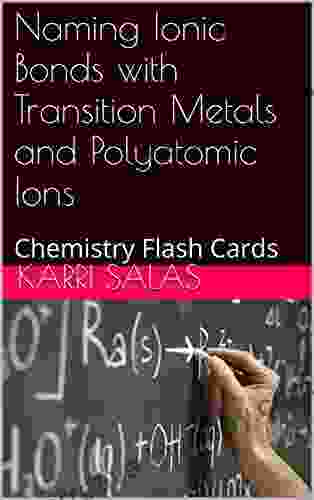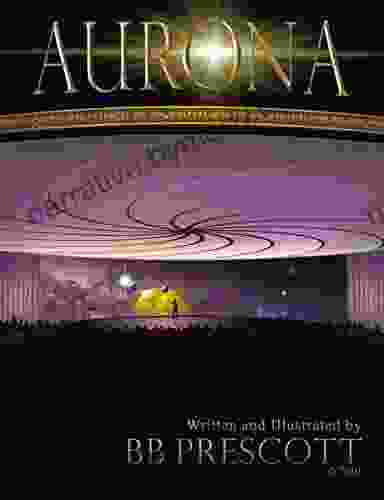Naming Ionic Bonds With Transition Metals And Polyatomic Ions: The Ultimate Guide

Ionic bonding is a fundamental concept in chemistry, involving the attraction between positively charged ions (cations) and negatively charged ions (anions). Transition metals and polyatomic ions add complexity to ionic bonding, but understanding their naming conventions is crucial for success in chemistry.
5 out of 5
| Language | : | English |
| File size | : | 4449 KB |
| Screen Reader | : | Supported |
| Print length | : | 110 pages |
| Lending | : | Enabled |
This comprehensive guide will delve into the rules and strategies for naming ionic bonds with transition metals and polyatomic ions. By mastering these concepts, you will enhance your understanding of chemical nomenclature, excel in your chemistry studies, and gain a solid foundation for advanced chemistry coursework.
Transition Metals
Transition metals are elements from the d-block of the periodic table. They have incomplete d-orbitals, resulting in variable oxidation states. This unique characteristic impacts the naming of their ionic compounds.
Naming Cations of Transition Metals
In ionic compounds, transition metals form cations. To name a cation of a transition metal, follow these steps:
- Write the name of the metal.
- Use Roman numerals in parentheses to indicate the oxidation state of the metal.
- Add the suffix "-ium".
Example: Fe3+ is named iron(III) ion.
Polyatomic Ions
Polyatomic ions are groups of atoms that carry a net charge. They have unique names and formulas, which must be memorized for successful ionic bond naming.
Table of Common Polyatomic Ions
Here is a table of common polyatomic ions:
| Name | Formula | Charge |
|---|---|---|
| Ammonium ion | NH4+ | +1 |
| Hydroxide ion | OH- | -1 |
| Nitrate ion | NO3- | -1 |
| Sulfate ion | SO42- | -2 |
| Carbonate ion | CO32- | -2 |
Naming Ionic Compounds with Transition Metals and Polyatomic Ions
To name an ionic compound containing a transition metal and a polyatomic ion, follow these steps:
- Name the cation of the transition metal, including the oxidation state.
- Name the polyatomic ion, without changing its name or charge.
Example: The ionic compound Fe2(SO4)3 is named iron(III) sulfate.
Practice Exercises
To solidify your understanding, try these practice exercises:
- Name the cation: Mn2+
- Name the polyatomic ion: NO2-
- Name the ionic compound: Co3(PO4)2
Answers:
- Manganese(II) ion
- Nitrite ion
- Cobalt(III) phosphate
Mastering the naming of ionic bonds with transition metals and polyatomic ions is essential for your success in organic chemistry. By following the rules and strategies outlined in this guide, you will gain a thorough understanding of chemical nomenclature and enhance your overall understanding of chemistry. Remember to practice regularly, and don't hesitate to seek help when needed. Best wishes in your chemistry endeavors!
5 out of 5
| Language | : | English |
| File size | : | 4449 KB |
| Screen Reader | : | Supported |
| Print length | : | 110 pages |
| Lending | : | Enabled |
Do you want to contribute by writing guest posts on this blog?
Please contact us and send us a resume of previous articles that you have written.
 Book
Book Novel
Novel Page
Page Chapter
Chapter Text
Text Story
Story Genre
Genre Reader
Reader Library
Library Paperback
Paperback E-book
E-book Magazine
Magazine Newspaper
Newspaper Paragraph
Paragraph Sentence
Sentence Bookmark
Bookmark Shelf
Shelf Glossary
Glossary Bibliography
Bibliography Foreword
Foreword Preface
Preface Synopsis
Synopsis Annotation
Annotation Footnote
Footnote Manuscript
Manuscript Scroll
Scroll Codex
Codex Tome
Tome Bestseller
Bestseller Classics
Classics Library card
Library card Narrative
Narrative Biography
Biography Autobiography
Autobiography Memoir
Memoir Reference
Reference Encyclopedia
Encyclopedia Jim Davis
Jim Davis Tonya Bolden
Tonya Bolden Brian C Hailes
Brian C Hailes Bb
Bb Barbara S Garriel
Barbara S Garriel Jonathan Drori
Jonathan Drori Attilio D Alberto
Attilio D Alberto Elizabeth Foss
Elizabeth Foss Bebe Harper
Bebe Harper Kathe Hamilton
Kathe Hamilton Scott Bukatman
Scott Bukatman William D Larue
William D Larue Charlotte Foltz Jones
Charlotte Foltz Jones Ashlee Kasten
Ashlee Kasten Barbara Grizzuti Harrison
Barbara Grizzuti Harrison William Middleton
William Middleton Colin R Turner
Colin R Turner Ayaan Hirsi Ali
Ayaan Hirsi Ali John C Stickler
John C Stickler Rosemary Mahoney
Rosemary Mahoney
Light bulbAdvertise smarter! Our strategic ad space ensures maximum exposure. Reserve your spot today!

 Ben HayesUnleash the Thunder: Dive into the Electrifying World of Michael Vey: Fall of...
Ben HayesUnleash the Thunder: Dive into the Electrifying World of Michael Vey: Fall of...
 Dan HendersonAnother Man War: A Captivating Exploration of War, Identity, and the Human...
Dan HendersonAnother Man War: A Captivating Exploration of War, Identity, and the Human... Douglas FosterFollow ·17.6k
Douglas FosterFollow ·17.6k Abe MitchellFollow ·19.9k
Abe MitchellFollow ·19.9k Eric HayesFollow ·9.3k
Eric HayesFollow ·9.3k Guillermo BlairFollow ·3.5k
Guillermo BlairFollow ·3.5k Kazuo IshiguroFollow ·6.5k
Kazuo IshiguroFollow ·6.5k D'Angelo CarterFollow ·8.4k
D'Angelo CarterFollow ·8.4k Rudyard KiplingFollow ·13.8k
Rudyard KiplingFollow ·13.8k Reed MitchellFollow ·6.4k
Reed MitchellFollow ·6.4k

 Ian McEwan
Ian McEwanWhy Didn't Anyone Say Anything? Uncovering the Hidden...
By [Author's...

 William Wordsworth
William WordsworthArthurian Legendarians: Faithless One - Part One – A...
In the realm of legendary tales, the...

 Corey Hayes
Corey HayesSSAT ISEE Prep Test: Arithmetic Review Flash Cards Cram...
Are you preparing for the SSAT or ISEE exam?...

 Robert Louis Stevenson
Robert Louis StevensonUnveiling the Essential Guide to Compliance: BCBS 239...
In the ever-evolving...

 Javier Bell
Javier BellJust Peachy: A Tale of Sweetness and Sassiness
Immerse yourself in a...

 Brent Foster
Brent FosterStep-by-Step Instruction Manual to Building a Real Estate...
Are you eager to embark on the...
5 out of 5
| Language | : | English |
| File size | : | 4449 KB |
| Screen Reader | : | Supported |
| Print length | : | 110 pages |
| Lending | : | Enabled |








